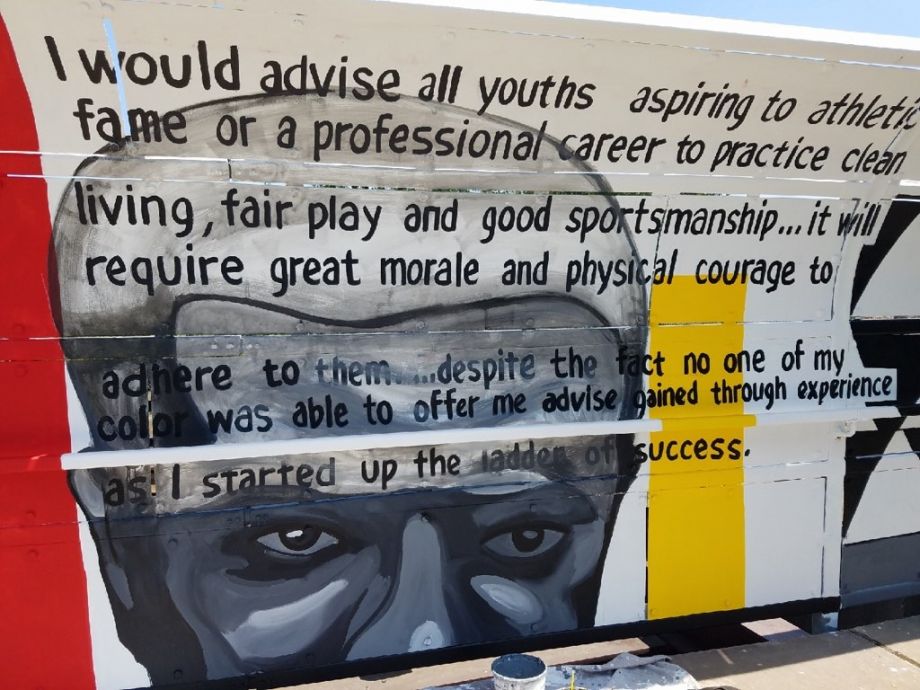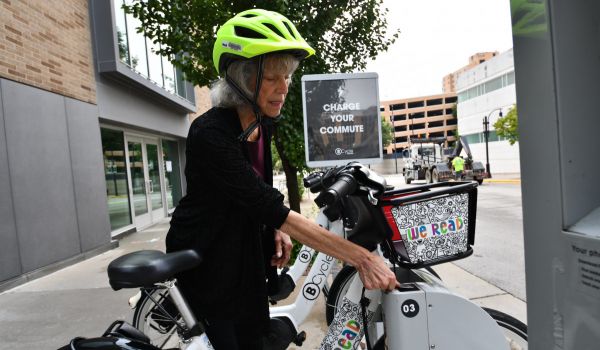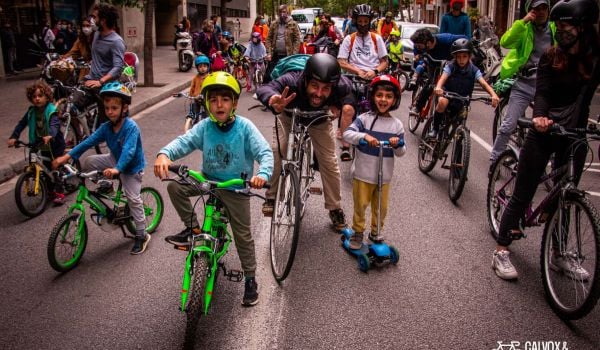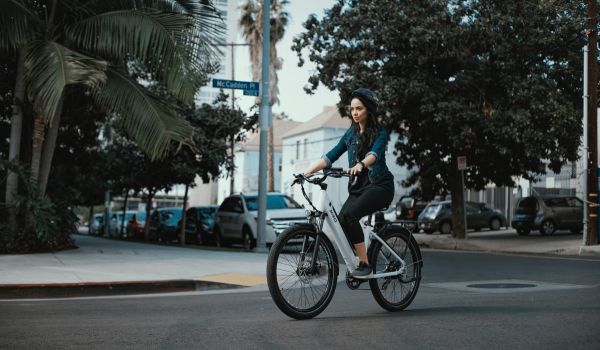Fans of an underused Chicago bike path that’s more than 6 miles long hope a welcoming new mural will encourage more cycle traffic and amplify the green space’s value as an important community asset. They want the artwork, which was created with input from current users, to spur additional investment and boost the larger effort to make Marshall “Major” Taylor Trail a more popular destination.
“[The trail] has brought the community together,” says Peter Taylor, president of Friends of the Major Taylor Trail. He says that back when the path was a defunct rail line, it was a “dividing line, a dumping ground, an eyesore. Now residents use the trail to walk and ride. But many are still unaware and uninvolved.”
The Major Taylor Trail runs north to south through several far south side Chicago neighborhoods. The new 400-foot-long mural is on a bridge that crosses the Little Calumet River in the West Pullman neighborhood. The work documents the life of Marshall “Major” Taylor, for whom the trail was named when it opened in 2007.
Born in rural Indiana in 1878, Taylor grew up in Indianapolis. He got his first bike when he was about 12. A local bike shop hired him to perform stunts outside the shop wearing a soldier’s uniform. That’s where he picked up the “Major.” At age 13, Taylor entered his first bicycle race as a joke — and won. He went on to race regularly and frequently called out racism in the track competition world. By 1899, he held seven world records. He wrote an autobiography called “The Fastest Bicycle Rider in the World.”
Despite his talent and accomplishments, at the end of his life, Taylor faced poor health and poverty, and he died in 1932 in the charity ward of Chicago’s Cook County Hospital. In 1948, a group of bicycle enthusiasts, including Frank Schwinn, arranged to have Taylor’s body exhumed and reinterred in a gravesite in Mount Glenwood, Illinois, not far from the bicycle trail that bears his name.
“We should be honoring him the way you hear Jackie Robinson, Jesse Owens. That’s how the name Major Taylor should be known as well,” says Brenda Dixon, who founded Community and Neighborhood Improvement Projects (CNIP) to keep the mural project moving forward. Dixon lives eight blocks away from the 115th Street section of the trail.
The muralist, Chicago artist Bernard Williams, designed with that educational goal in mind. The mural panels include dates of Taylor’s championships, names of cities where he raced, and visual representations of the cyclist. Williams, who was born on the far south side, read “The Fastest Bicycle Rider in the World” after he got the commission.
“It really situated him as kind of an international individual and a person who traveled the world in a time that very few African-Americans were maybe able to do something like that,” Williams says. “And that’s what I really tried to communicate in the mural. This person who maybe opened up the space for us to think about ourselves as part of an international arena. And that there’s a large world out there in front of us and there’s a potential to kind of experience that in some way, through our talents, our gifts and whatever interests or motivations you might have.”
Williams got input from people who currently love and use the trail too, including members of the Major Taylor Cycling Club of Chicago.
“We talked about Major Taylor’s personal story, the historical moment, you know, the early 1900s in America and across the globe, because he was kind of an international star,” Williams says. “So I just kind of gathered information from them about their interest in Major Taylor and what they envisioned the mural might accomplish. I asked questions like ‘Who is Major Taylor to you?,’ ‘Why is Major Taylor important for the community?’”
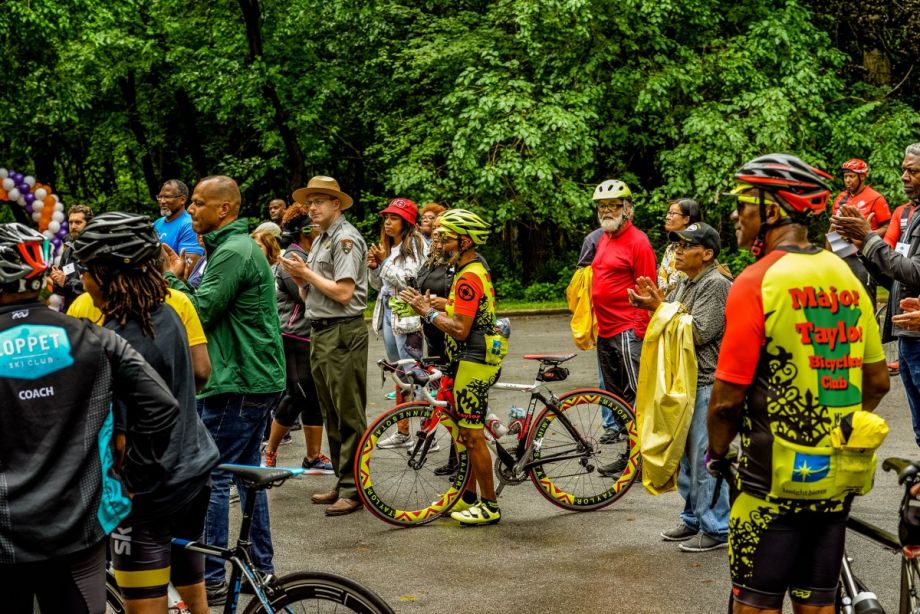
Cyclists celebrate a new mural for Major Taylor Trail. (Photo by Jason Ward/Jayloo Photography)
Much of the trail runs through picturesque preserved forest. Nonetheless, large segments are uninviting, especially on its south end. There are few amenities such as benches and lighting. And before the creation of the mural, the bridge that forms the portion of the trail that crosses the Little Calumet River was covered with graffiti, according to Dixon.
“It’s such a beautiful area but people are afraid because you see the graffiti, and you’re like ‘Oh my God, I don’t want to go there,’” says Dixon.
Dixon was determined to see the graffiti eradicated — especially since future plans are in place to connect Major Taylor Trail to other trails in the city. The future network of trails means a potential increase in ridership. Dixon applied for grant funding, and that eventually led to her forming CNIP, in order to administer the funds that were awarded, along with the Active Transportation Alliance, which served as fiscal agent for the grant.
According to Dixon, now that the mural has been completed and unveiled — there was a ribbon-cutting on July 21 and Taylor’s great-great-grandson held the ceremonial scissors — there’s plenty more to do on Major Taylor Trail. She is especially concerned with making people aware that the trail is a continuous entity through the neighborhoods it connects. One way to do so is by creating consistent signage, according to Dixon.
The trail runs through five different wards and is managed by three different entities: Forest Preserve District of Cook County, the Chicago Park District and the Chicago Department of Transportation. All three use different trail markers.
“One of my dreams and visions for the trail is that we would get all five of those wards [and] all three of those entities to sit at the table together and agree on ‘OK, let’s use this logo as the consistent theme that all three of us will use for the trail.’ So that people know that this trail runs from the Little Calumet River all the way up to the Dan Ryan Woods at the north end, that these aren’t separate entities from each other,” Dixon says.
She won’t stop there when it comes to her mission to bring proper recognition to Major Taylor and enhance his namesake trail.
“I travel all over the country for cycling,” Dixon says. “And it just saddens me when … I come home to my neighborhood and I see that I have a trail but it doesn’t have any of the amenities that the other trails [have] when I go to other cities and ride. [Major Taylor Trail runs] through the heart of our community, named after just a phenomenal athlete, an African-American athlete. Let’s make it something beautiful that’s going to be the pride of our community. … Give me about five years and it’s going to be transformed.”
This article is part of “For Whom, By Whom,” a series of articles about how creative placemaking can expand opportunities for low-income people living in disinvested communities. This series is generously underwritten by the Kresge Foundation.

Audrey F. Henderson is a Chicagoland-based freelance writer and researcher specializing in sustainable development in the built environment, culture and arts related to social policy, socially responsible travel, and personal finance. Her work has been featured in Transitions Abroad webzine and Chicago Architect magazine, along with numerous consumer, professional and trade publications worldwide.

